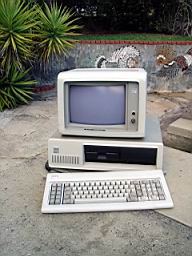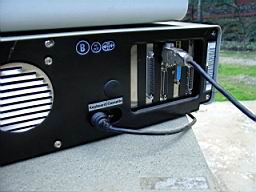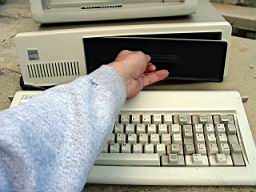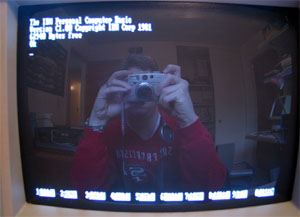Well, be honest here!







Personal Computers Approach 25 Years Anniversary.
IBM PC 5150 Turns Quarter of a Century
by Anton Shilov
[ 08/07/2006 ]
Back on August 12, 1981, International Business Machines introduced what the world knows as PC – or personal computer – today. Since then, not only the industry of computers has evolved, but the world has changed tremendously.
The world’s first IBM PC was introduced at a press conference at the Waldorf Astoria ballroom in New York City, Priced at $1565, the device could offer more than a two decades old IBM computer, which often cost as much as $9 million and required an air-conditioned quarter-acre of space and a staff of 60 people to keep it fully loaded with instructions. The new IBM PC could not only process information faster than those earlier machines but it could hook up to the home TV set, play games, process text and harbor more words than a fat cookbook, IBM indicates.
Especially for the IBM PC 5150 the currently world’s largest chipmaker Intel Corp. developed a cut-down version of the 8086 processor called Intel 8088 with reduced cost. The first personal computer in its premium incarnation was based on the 8088 chip running at 4.77MHz, featured 256KB of memory and could store up to 160KB of data on a 5.25†floppy disk.
Even though many analysts and observers considered IBM PC “inferior†compared to Apple II system or other competitors, IBM managed to sell over 240 thousand of such systems in the first two years, according to some reports.
From the very beginning, IBM engineers took open architecture approach to the PC, which lead to availability of desktop computers running Microsoft’s disk operating system (DOS) assembled in everywhere in the world – from state of the art facilities in New York to sweatshops in Asia. Starting from 240 thousand of units sold per year in 1981 – 1982, the annual PC sales two and a half decade later are estimated to account for 230.2 million computers.
Nowadays personal computers are used in nearly all the industries and present opportunities to conduct deals, communicate, compute, host mission critical data, play games and much more.
IBM PC 5150 Turns Quarter of a Century
by Anton Shilov
[ 08/07/2006 ]
Back on August 12, 1981, International Business Machines introduced what the world knows as PC – or personal computer – today. Since then, not only the industry of computers has evolved, but the world has changed tremendously.
The world’s first IBM PC was introduced at a press conference at the Waldorf Astoria ballroom in New York City, Priced at $1565, the device could offer more than a two decades old IBM computer, which often cost as much as $9 million and required an air-conditioned quarter-acre of space and a staff of 60 people to keep it fully loaded with instructions. The new IBM PC could not only process information faster than those earlier machines but it could hook up to the home TV set, play games, process text and harbor more words than a fat cookbook, IBM indicates.
Especially for the IBM PC 5150 the currently world’s largest chipmaker Intel Corp. developed a cut-down version of the 8086 processor called Intel 8088 with reduced cost. The first personal computer in its premium incarnation was based on the 8088 chip running at 4.77MHz, featured 256KB of memory and could store up to 160KB of data on a 5.25†floppy disk.
Even though many analysts and observers considered IBM PC “inferior†compared to Apple II system or other competitors, IBM managed to sell over 240 thousand of such systems in the first two years, according to some reports.
From the very beginning, IBM engineers took open architecture approach to the PC, which lead to availability of desktop computers running Microsoft’s disk operating system (DOS) assembled in everywhere in the world – from state of the art facilities in New York to sweatshops in Asia. Starting from 240 thousand of units sold per year in 1981 – 1982, the annual PC sales two and a half decade later are estimated to account for 230.2 million computers.
Nowadays personal computers are used in nearly all the industries and present opportunities to conduct deals, communicate, compute, host mission critical data, play games and much more.











Comment